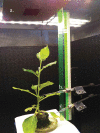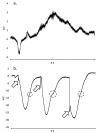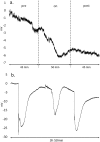Microwave radiation alters burn injury-evoked electric potential in Nicotiana benthamiana
- PMID: 29944441
- PMCID: PMC6110360
- DOI: 10.1080/15592324.2018.1486145
Microwave radiation alters burn injury-evoked electric potential in Nicotiana benthamiana
Abstract
The dielectric effect enforced on charged ions and dipolar molecules by the oscillating electric field of microwaves may influence electric signaling in plants. In the present study, the exposure of Nicotiana benthamiana plants to continuous wave 2.45 GHz microwave radiation with 1.9 - 2.1 W m-2 power density significantly reduced the amplitude of leaf burning-induced variation potential along the plant stem. The change in amplitude of the variation potential occurred mainly because of a significant reduction of the depolarization rate. This effect was not observed during the post-microwave exposure period. The unique characteristics observed in the variation potentials were also observed under microwave exposure, suggesting unaffected information delivery to distant locations or unaffected transport of specific chemicals generated by the injury.
Keywords: Abiotic stress; electromagnetic radiation; non-thermal effect; plant signaling; wounding.
Figures




Similar articles
-
Assessing the biochemical and genotoxic effects of low intensity 2.45GHz microwave exposure on Arabidopsis thaliana plants.Electromagn Biol Med. 2024 Oct;43(4):303-311. doi: 10.1080/15368378.2024.2411629. Epub 2024 Oct 3. Electromagn Biol Med. 2024. PMID: 39361824
-
Nonthermal microwave radiations affect the hypersensitive response of tobacco to tobacco mosaic virus.J Altern Complement Med. 2004 Dec;10(6):947-57. doi: 10.1089/acm.2004.10.947. J Altern Complement Med. 2004. PMID: 15673988
-
Sunflower exposed to high-intensity microwave-frequency electromagnetic field: electrophysiological response requires a mechanical injury to initiate.Plant Signal Behav. 2015;10(1):e972787. doi: 10.4161/15592316.2014.972787. Plant Signal Behav. 2015. PMID: 25482761 Free PMC article.
-
Influence of microwave frequency electromagnetic radiation on terpene emission and content in aromatic plants.J Plant Physiol. 2014 Sep 15;171(15):1436-43. doi: 10.1016/j.jplph.2014.06.013. Epub 2014 Jul 8. J Plant Physiol. 2014. PMID: 25050479 Free PMC article.
-
Is chloroplast movement in tobacco plants influenced systemically after local illumination or burning stress?J Integr Plant Biol. 2008 Oct;50(10):1292-9. doi: 10.1111/j.1744-7909.2008.00743.x. J Integr Plant Biol. 2008. PMID: 19017116
Cited by
-
Electrode insertion generates slow propagating electric potentials in Myriophyllum aquaticum plants.Plant Signal Behav. 2020 Mar 3;15(3):1734332. doi: 10.1080/15592324.2020.1734332. Epub 2020 Feb 26. Plant Signal Behav. 2020. PMID: 32100609 Free PMC article.
References
-
- Pont A, Pujolle G, Raghavan SV. Communications: wireless in developing countries and networks of the future. Springer, 2010, IFIP Advances in information and communication technology, 978-3-642-15475-1. doi: 10.1007/978-3-642-15476-8. - DOI
Publication types
MeSH terms
LinkOut - more resources
Full Text Sources
Other Literature Sources
